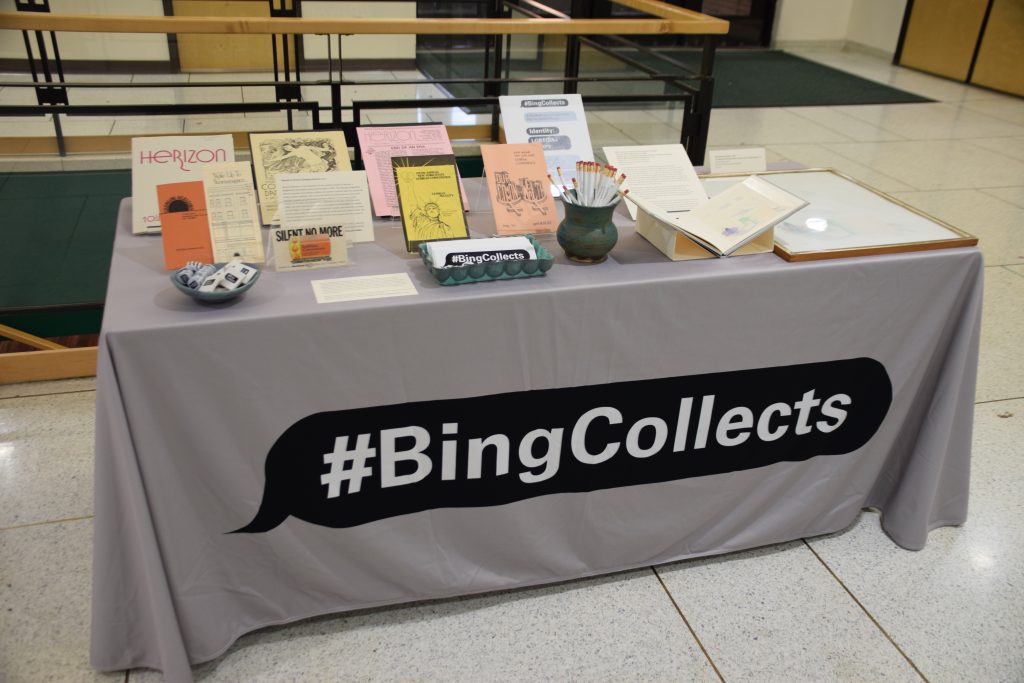In the 2022-23 academic year, the Binghamton University Art Museum and BU’s libraries’ Special Collections are joining forces to present various pop-up exhibits focused on awareness of different heritages and identities. The exhibits project is titled #BingCollects.
The identity theme has presented itself in two exhibits already this past month. One focused on Native American heritage, and was displayed on Oct. 6 at the Appalachian Collegiate Center, and the other was on celebrating LBGTQIA+ history, displayed on Oct. 26 at the University Union. There will be one more exhibit on Nov. 14, from 12 p.m. to 2 p.m., in the Glenn G. Bartle Library breezeway, presenting Native American Heritage. Next semester will see another three pop-ups at different places around campus.
#BingCollects began back in February 2020 before the COVID-19 pandemic hit. Blythe Roveland-Brenton, ’83, director of Special Collections and Library Preservation, reached out to Claire Kovacs, curator of collections and exhibitions at the BU Art Museum (BUAM), to inquire about a partnership for a pop-up exhibit project. With COVID-19 causing a lengthy delay, Roveland-Brenton and Kovacs were ready this year to put the plan into reality.
Roveland-Brenton wrote about excitement to see their goal finally realized.
“Our purpose for #BingCollects is to generate more awareness, especially among students, that both repositories and the material in them are available to them to explore and use for their studies,” Roveland-Brenton wrote in an email. “We thought we’d be more successful in introducing our rich resources by taking objects out of their usual homes and bringing them to various spaces at different days and times where and when students gather.”
Once Kovacs and Roveland-Brenton decided on their theme of identity, they began to each take works from their respective collections to start the planning process. Kovacs mentioned how this theme was more than just objects to look at — it was also a way to connect to students.
“It’s important because I don’t want our collections to be seen as static and sterile objects with zero connections to folks,” Kovacs said. “As we’re choosing objects around different identity themes, part of our goal is to allow students to see works in our collection that resonate with parts of their identity.”
The Oct. 6 exhibit at the Appalachian Collegiate Center featured a variety of intriguing works of the past. Special Collections showcased an array of historical items from the University archives related to the Latin American Student Union and its predecessors over 50 years ago. BUAM took highlights of artwork and writings from The Border Art Workshop/Taller de Arte Fronterizo, a group of Anglo-American, Mexican and Chicano artists working on issues of the border between Mexico and California.
LGBTQIA+ history was represented later in October with art prints from the book “The Blue Guitar: Etchings by David Hockney Who Was Inspired by Wallace Stevens Who Was Inspired by Pablo Picasso” by David Hockney, a well-known queer artist, which was taken from BUAM’s collection. Some may be surprised that the prints don’t center on Hockney’s typical subject matter — his queer identity. Instead, these prints draw on other influences in Hockney’s life that he resonates with. Kovacs commented on the social pressure of queer artists to only create queer-centric art.
“Just because someone is an artist that identifies in a particular way doesn’t make them beholden to create work around that identity,” Kovacs said.
On the Special Collections side, Roveland-Brenton pulled out archival material from Herizon, a lesbian social club based in Binghamton that existed from 1975 to 1991.
Their upcoming exhibit in the middle of Native American Heritage month will have many exciting objects and works featured. While most of it is kept under wraps, Kovacs discussed one object recently acquired for the exhibit, a two-row Wampum belt replica created by Tony Gonyea from the Onondaga Nation. Its importance lies in the fact that the belt was the first treaty between the Dutch and Haudenosaunee confederacy in 1613. Kovacs emphasized the preservation of the original artifacts these replicas come from.
“When these sorts of works go into museums, they are just replicas,” Kovacs said. “Any original wampums should be returned to the Haudenosaunee.”
Kovacs and Roveland-Brenton have enjoyed their collaboration thus far and cannot wait to continue this project into the next semester — not only to connect with students on a scholarly level but also on a personal level.
“In the spring we will celebrate Black History Month, among others,” Roveland-Brenton wrote in an email. “We’re hoping that more students will seek out the #BingCollects pop-ups and are inspired to visit the Art Museum and Special Collections for their own intellectual curiosity and scholarship as a result.”



